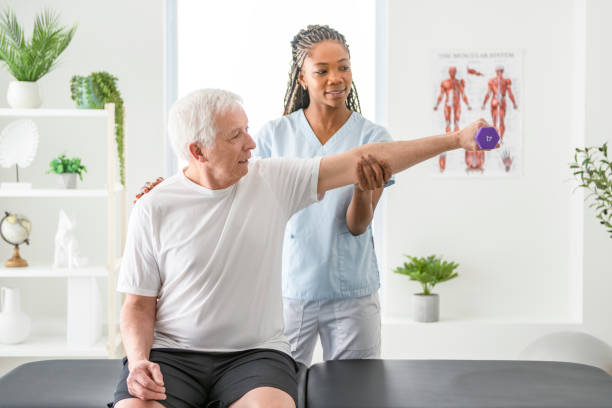Navigating the complexities of neurological conditions can be challenging for seniors, but adapted physical therapy offers a pathway to improved quality of life, enhanced mobility, and increased independence. As the body ages, the likelihood of developing neurological conditions such as Parkinson’s disease, stroke, and multiple sclerosis increases. This underscores the essential need for targeted interventions that address the unique needs of elderly patients.
Contents
Understanding Common Neurological Conditions in Seniors
Understanding the various neurological conditions that commonly affect seniors is crucial for developing effective therapeutic strategies. These conditions, including Parkinson’s disease, stroke, and multiple sclerosis, present distinct challenges that require specialized care. By comprehensively examining these ailments, we can more accurately tailor physical therapy interventions to meet the specific needs of elderly patients, ensuring they receive the most effective and compassionate care possible.
Parkinson’s Disease
Parkinson’s disease is a progressive neurological disorder characterized by tremors, stiffness, and difficulty with balance and coordination. Often resulting in decreased mobility, it severely impacts the quality of life for many seniors. Therapy strategies need to focus on maintaining functional ability and preventing falls.
Stroke
A stroke occurs when the blood supply to part of the brain is interrupted, causing brain cells to die. This can lead to significant impairments in motor function, speech, and cognition. Early intervention with physical therapy can drastically improve outcomes and enhance recovery.
Multiple Sclerosis
Multiple sclerosis (MS) is an autoimmune condition where the immune system attacks the protective sheath (myelin) that covers nerve fibers. This causes communication problems between the brain and the rest of the body. Symptoms vary widely but can include fatigue, pain, and difficulty walking, making adapted physical therapy crucial for managing these issues.
Adapting Physical Therapy for Neurological Conditions
To effectively manage neurological conditions in elderly patients, it is paramount to adapt physical therapy techniques to their specific needs. Personalized therapy plans not only address the unique symptoms associated with each condition but also empower patients to regain and maintain their independence. A solution-oriented approach, rooted in empathy and clinical expertise, can significantly enhance the overall quality of life for those affected by these complex disorders.
Comprehensive Assessment
A thorough assessment is essential to tailoring physical therapy effectively. This includes evaluating the patient’s medical history, functional capabilities, and specific neurological symptoms. Using standardized tests, therapists can determine the severity of the condition and develop a targeted treatment plan.
Personalized Intervention Plans
Each neurological condition affects individuals differently. A personalized intervention plan considers the unique needs of the patient, focusing on improving mobility, strength, and functionality. Goals should be realistic and achievable, promoting patient motivation and adherence to the therapy regimen.
Strengthening and Flexibility Exercises
Resistance training can aid in preserving muscle mass and enhancing strength, which is particularly beneficial for seniors. Flexibility exercises, such as gentle stretching or yoga, can improve range of motion and reduce stiffness, making daily activities more manageable.
Implementing Therapy for Maximum Benefit

Effective implementation of physical therapy is crucial to ensuring elderly patients derive the maximum benefit from their treatment plans. By combining evidence-based practices with a compassionate approach, therapists can address physical limitations and empower patients to achieve their full potential. This section delves into strategies and best practices for optimizing therapy outcomes, ensuring each session contributes meaningfully to the patient’s journey toward improved health and independence.
Consistent Scheduling and Supervised Sessions
Regular, supervised therapy sessions ensure that exercises are performed correctly and safely. Consistency in scheduling allows for gradual progression and adaptation, which is integral to long-term success.
Monitoring Progress and Adjusting Plans
Regular evaluations of a patient’s progress facilitate timely adjustments to the therapy plan, ensuring that it remains effective and aligned with the patient’s evolving needs. This approach helps in addressing any setbacks promptly and reinforces positive outcomes.
Incorporating Technology and Modern Techniques
In the rapidly evolving field of physical therapy, integrating technology and modern techniques can significantly enhance patient outcomes. By leveraging advanced tools and innovative approaches, therapists can provide personalized, efficient, and effective treatment plans. This section explores the latest advancements and how they can be seamlessly incorporated into therapy regimens to offer superior care and foster greater independence among elderly patients.
Use of Assistive Devices
Assistive devices such as walkers, canes, and orthotic supports can play a critical role in enhancing mobility and safety. Selecting the appropriate device and teaching proper usage is a crucial component of adapted physical therapy.
Telehealth and Virtual Therapy Sessions
With advancements in telehealth, seniors can now access physical therapy services from the comfort of their homes. Virtual therapy sessions enable continuous care and guidance, particularly for those with mobility constraints or those living in remote areas.
Innovative Therapy Techniques
Emerging techniques such as aquatic therapy, functional electrical stimulation (FES), and robotic-assisted therapy offer promising outcomes for seniors with neurological conditions. These methods provide alternative avenues for improving strength, coordination, and motor function.
Encouraging Family and Caregiver Involvement
Active involvement of family members and caregivers is essential in the rehabilitation process of elderly patients. Their support not only enhances adherence to prescribed therapies but also provides a comforting and motivating environment crucial for recovery. This section will outline strategies to effectively engage family and caregivers, ensuring they contribute positively to the therapeutic journey and overall well-being of the patient.
Educating and Training Caregivers
The involvement of family members and caregivers is vital in the therapeutic process. Providing them with adequate training and resources ensures they can support the senior effectively, aiding in exercises and promoting a supportive environment.
Creating a Supportive Home Environment
Adapting the home environment to be more accessible and safe can significantly impact the effectiveness of physical therapy. Simple modifications such as installing grab bars, ensuring good lighting, and removing trip hazards can reduce the risk of falls and make daily activities easier.
Conclusion
Adapted physical therapy plays a pivotal role in managing neurological conditions in seniors, significantly improving their quality of life. Through comprehensive assessments, personalized care plans, and modern therapeutic techniques, seniors can achieve better mobility, strength, and independence. By incorporating consistent scheduling, monitoring progress, and involving family and caregivers, the therapeutic process becomes holistic and more effective. Embracing these strategies ensures that seniors living with neurological conditions receive the best possible care, leading to improved overall well-being.
